
In this series of articles, we have examined the concept of strategic planning, the analysis of the external environment, the conditions of the competitive and competitor environments, and performed an internal analysis.
To conclude, we will consider how to evaluate strengths, weaknesses, opportunities and threats using the SWOT model, then discuss the construction of SWOT strings. Finally, we will examine the utilization of specific matrices to determine future strategies for your practice.
SWOT Analysis
The SWOT model is an analysis of your practice based on the current conditions. The acronym “SWOT” stands for strengths, weaknesses, opportunities and threats. Strengths and weaknesses are the aspects that are considered internal, or occurring within your practice. Opportunities and threats are considered external, and occur in the greater world outside your practice.
Your practice’s strengths, weaknesses, opportunities and threats provide an excellent tool for thinking about your practice’s competitive position. Honest reflection will help you determine the distance between your current reality and your vision for the future.
Whether you think about strategic planning on an annual basis or just occasionally, a SWOT analysis can be a very useful tool. If you employ staff members, you might wish to involve them in the SWOT analysis, because they can provide you with a broader view. Team members such as associates, technicians and/or office staff all bring a different perspective and can be very valuable in seeing the most accurate picture of your practice.
Strengths
Strengths are the positive attributes that are specific to your practice. As you consider your strengths, think about the unique resources you offer clients, what you hear on the “horse grapevine” about your practice, what clients praise your practice for most frequently, what you hear about why horse owners leave competitors’ practices and choose yours, and the services in which you feel your practice excels.
Weaknesses
Weaknesses are the negative attributes in your practice. These could be skills or equipment you lack, or unpopular office policies. Think about what your employees tend to gripe about, what things your clients complain about, where you feel your team needs improvement, and what horse owners tell you when they quit your practice for another.
While it can be daunting, you need to be brutally realistic about the unpleasant truths about your practice.
Fortunately, the weaknesses you discover mighty have the potential to be turned into strengths if they are addressed creatively.
One of the ways to be more objective about the internal assessment of strengths and weaknesses is to use a survey. Using simple, free survey software such as Survey Monkey (www.surveymonkey.com) can make surveying easy and fun. Facebook also provides survey functionality, but as you are unable to screen out non-clients, the results might be less reliable.
The AAEP Touch program provides sample survey questions for gauging client satisfaction at https://touch.aaep.org/. If your practice is a large one, you might also wish to consider surveying your employees in order to have their anonymous responses.
Opportunities
Opportunities are trends or events that are happening in the world or in the equine industry that might present new directions for growth or services. These can include changes in technology, changes in buying preferences, changes in social patterns, population profiles, lifestyle changes or regional developments.
Examples of opportunities include: increasing wealth due to strong stock market performance; horses increasingly being considered as family members rather than livestock; and construction of regional equine competition venues. Recognizing all available opportunities is important, because they might be able to diminish a weakness or threat, or provide a new vision for growth.
Identifying opportunities requires consideration of a number of questions: Are there needs or desires of horse owners that are not currently being met? What are you hearing that your competitors are not doing well or at all? What new regional developments in the equine industry are occurring? Are you aware of any interesting trends, either within or outside of the equine industry?
Threats
Threats can result in loss of business and therefore add to your weaknesses. They are trends or events that are happening in the world or in the equine industry that might affect your business in a negative way. Examples of threats include a downturn in the global or local economy, a negative trend in the equine industry or equine veterinary industry, a change in client expectations or new technological advances.
Figure 1. Example of SWOT Analysis for ABC Equine
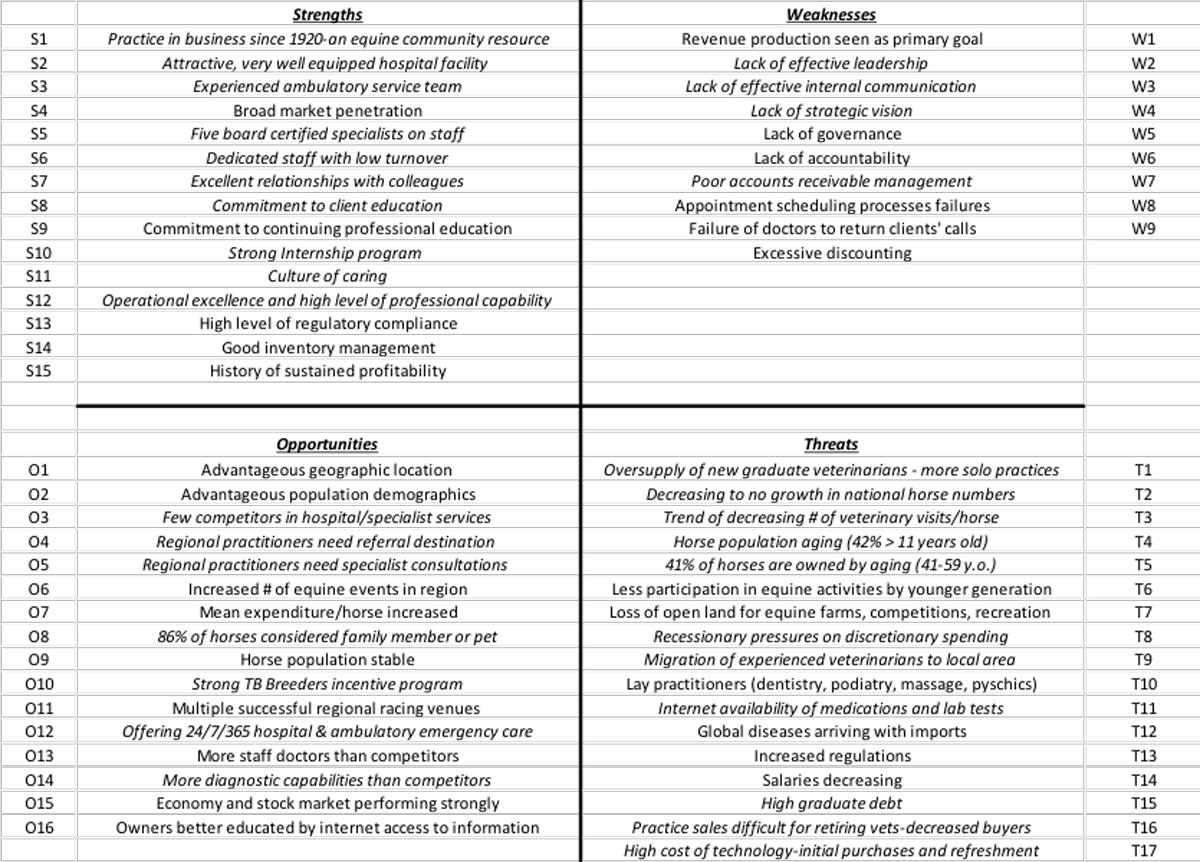
SWOT Strings
The next step in the analysis is to construct SWOT strings. To do this, one must identify the key issues in each quadrant of the SWOT summary table (see Figure 1). After identification, they are paired in logical chains. Issues in each internal quadrant are paired with associated issues in each external quadrant in turn. Then statements that address the paired issues are written.
Figure 2. SWOT Strings for ABC Equine

Analytic Matrices
Analytic matrices are then used to identify which strategies might specifically address the SWOT string pairings from the internal and external quadrants. The matrices provide a guide to which actions are possible. The matrix models include General Strategic Orientation, Attractiveness Grand Strategy and Investment Grand Strategy.
The purpose of the General Strategic Orientation matrix is to identify a general orientation or two that will guide in selecting among strategic options at the conclusion of working all three models.
First, you review the SWOT summary and decide the business’s positioning—is it working from a position of strength or weakness? This decision should not be driven by whether there are more numerical strengths or weaknesses. Instead, it is determined by understanding the firm’s capabilities and relevance in light of the external environment.
Next, one analyzes whether the threats the firm faces are more significant than the opportunities the business has waiting. Then the orientation of the firm is determined by placing it in the intersection of the selected quadrants. (See Figure 3. )
Figure 3. General Strategic Orientation
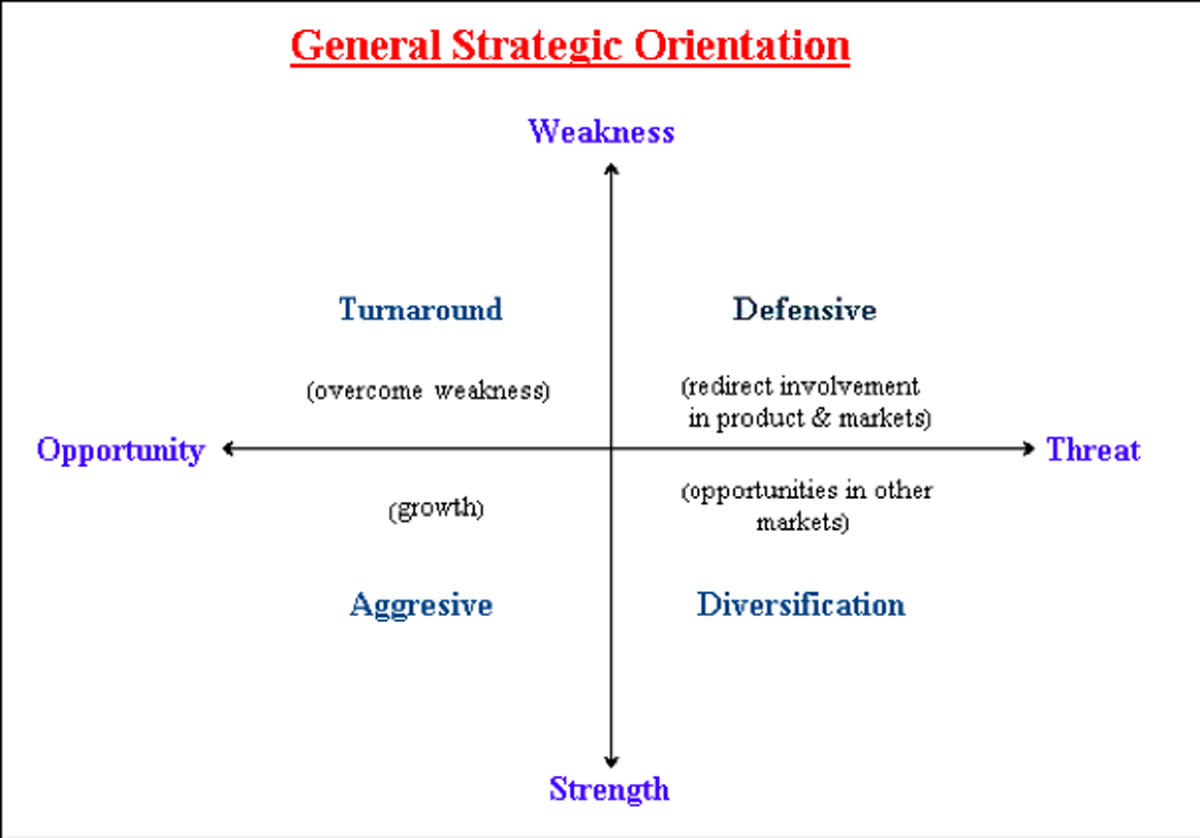
When working from a position of strength (e.g., sound financial position, strong leadership, operational excellence and/or numerous opportunities for growth), the business takes an aggressive stance in pursuit of growth strategies. In the case where threats are more salient than opportunities (e.g., slow growth, operational weaknesses and/or shifts in societal trends), the firm seeks opportunities in different or related markets through diversification.
If working from a position of weakness (e.g., poor organizational culture, no strong core competence and/or client service issues) and if there are numerous opportunities such as few competitors and demand for services outpacing supply, the business takes a turnaround stance. It will then work to eradicate weakness or reinforce existing strengths that can advantage opportunity.
In the case where threats are more salient than opportunities—such as declining markets, powerful competitors and changing industry demographics—the firm must take a defensive stance. It will then seek to redirect its resources into more promising products and markets.
In our example, ABC Equine is considered to be operating from a position of strength, equally challenged by threats as blessed by opportunities. Thus, it is positioned below the “x” axis in the Strength quadrants on the intersection of opportunity and threat (see Figure 4). The general strategies would therefore be growth and related diversification.
Figure 4. General Strategic Orientation for ABC Equine
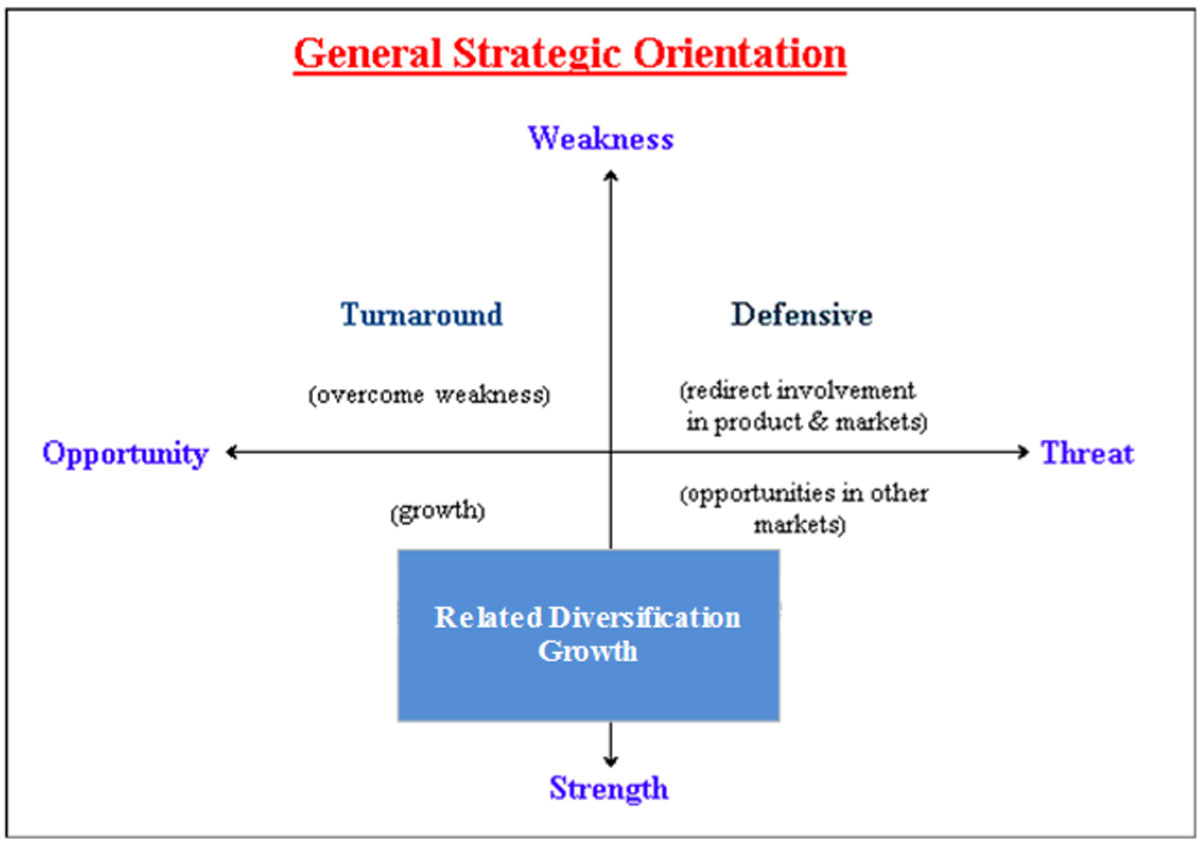
The Attractiveness Grand Strategy matrix integrates the firm’s competitive positioning and the growth stage of its market(s). First, a determination is made of how successful the firm is based on how it compares to rivals and how fast the business is growing. Then the orientation of the firm is determined by placing it in the intersection of the selected quadrants (see Figure 5).
Figure 5. Attractiveness Grand Strategy

In our example, ABC Equine is considered to be operating from an improving competitive position, but with slow growth. Thus, it is positioned below the “x” axis in the improving competitive position and slow growth quadrant (see Figure 6).
The appropriate strategies would therefore be related diversification, joint venture/alliance and concentrated growth. Concentrated growth seeks to reinforce the existing brand and increase awareness of the services being offered through increasing advertising and marketing efforts. Strategic alliances and joint ventures help manage the costs and uncertainties of a changing industry and allow the sharing of expertise. Related diversification seeks to leverage the existing brand loyalty by offering new services that transfer existing skills and economies of scope and scale.
Figure 6. Attractiveness Grand Strategy for ABC Equine
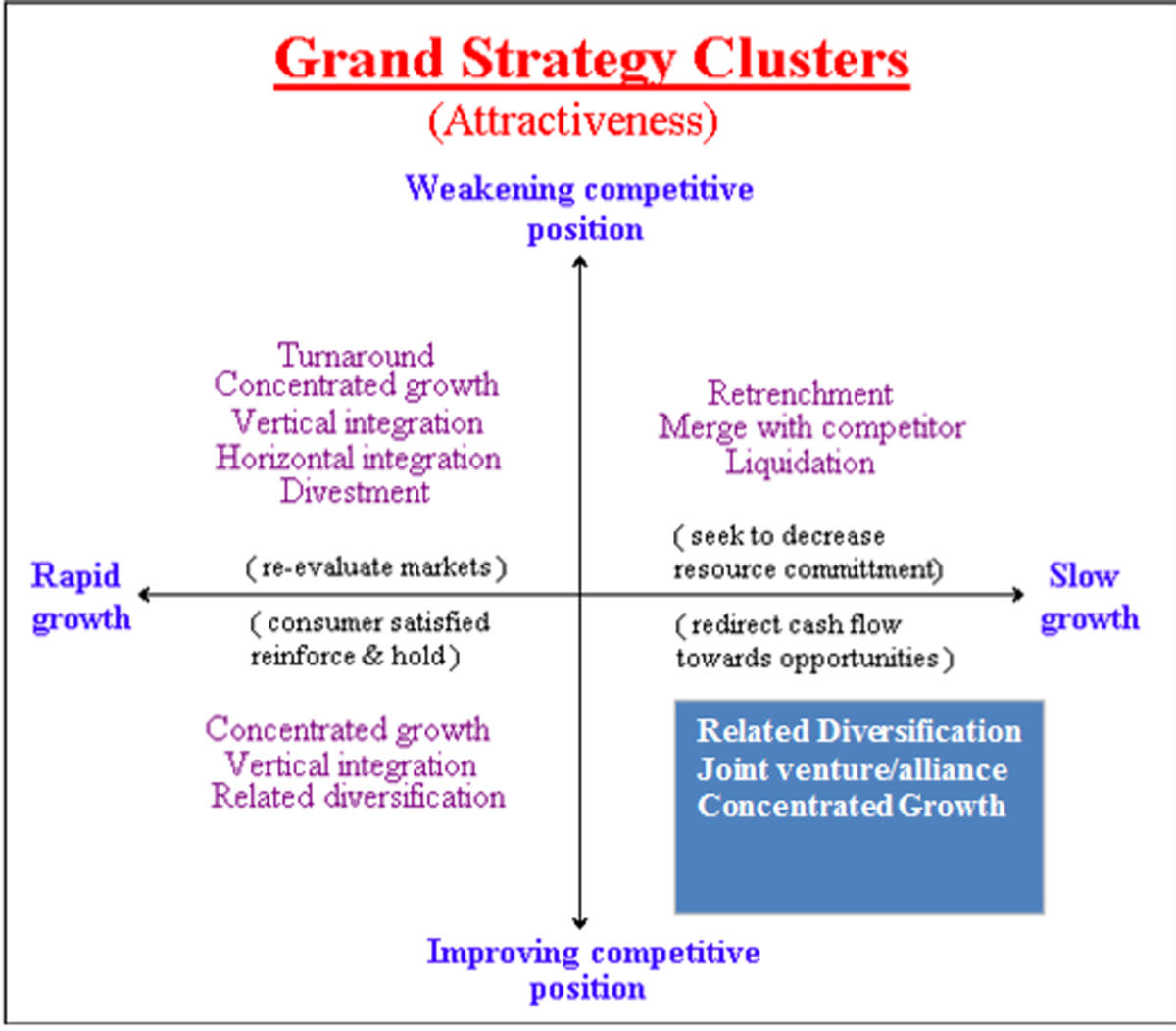
The Investment Grand Strategy matrix considers the firm’s investment orientation in light of its strengths and weaknesses. Some companies culturally and historically have demonstrated that they invest internally to develop new technologies, businesses or services. Conversely, external development reflects a firm’s orientation to seek solutions and pursue opportunities outside—to “buy” instead of “make” (see Figure 7).
When a business is operating from a position of strength—with strong core competencies, brand equity and/or intellectual capital—leveraging these resources will reinforce the current business or create the next generation of service. A firm that is operating from a position of weakness might be lacking the capacity to take advantage of growing markets, its core competence might not be a good fit with its chosen market or it has limited resources. Strategically, it needs to reposition its resources to markets with lower risk and more promise for expansion.
Figure 7. Investment Grand Strategy
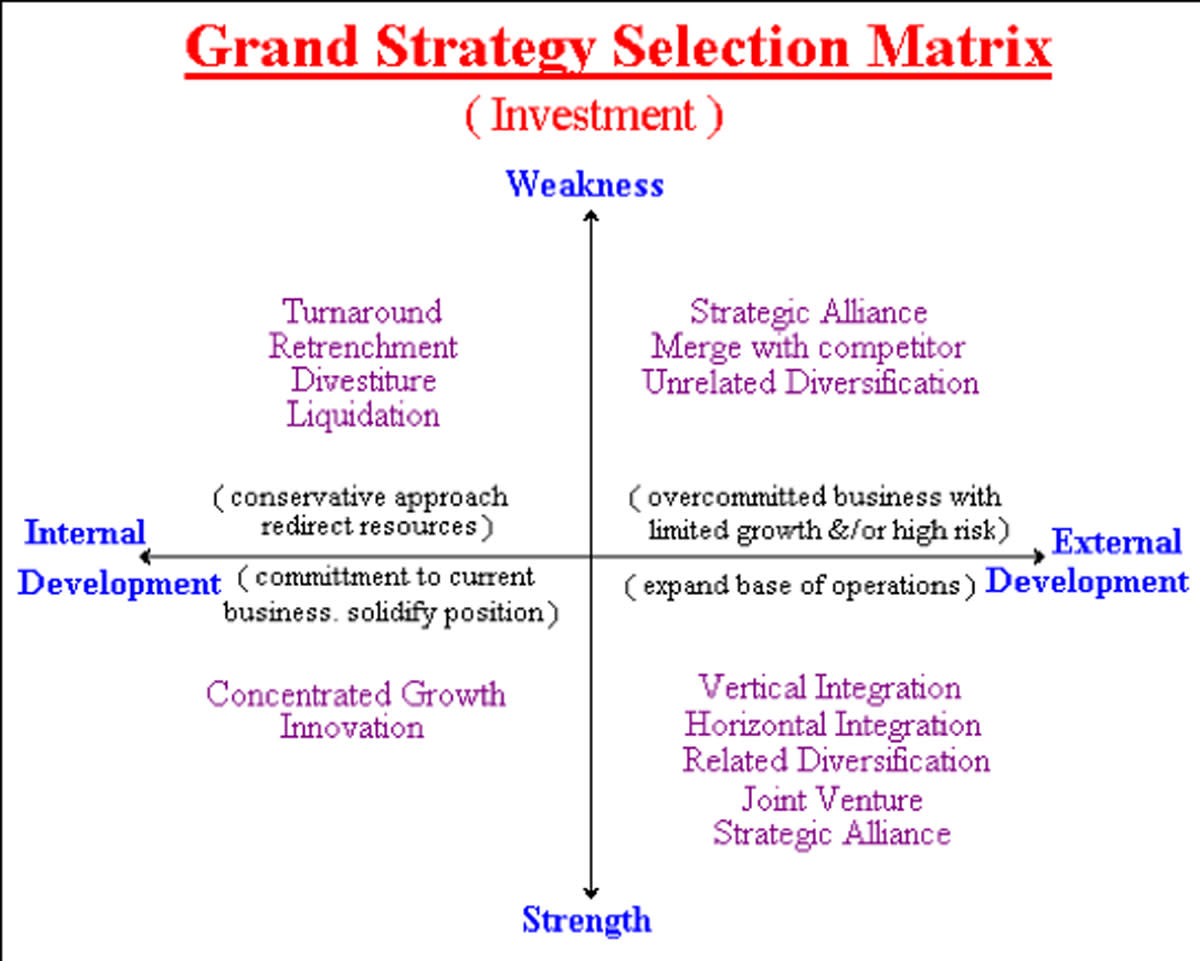
Our example practice, ABC Equine, is considered to be operating from a position of strength with a history of internal development. Thus, it is positioned below the “x” axis in the strength and internal development quadrant (see Figure 8). The strategy is then concentrated growth and innovation.
Figure 8. Investment Grand Strategy
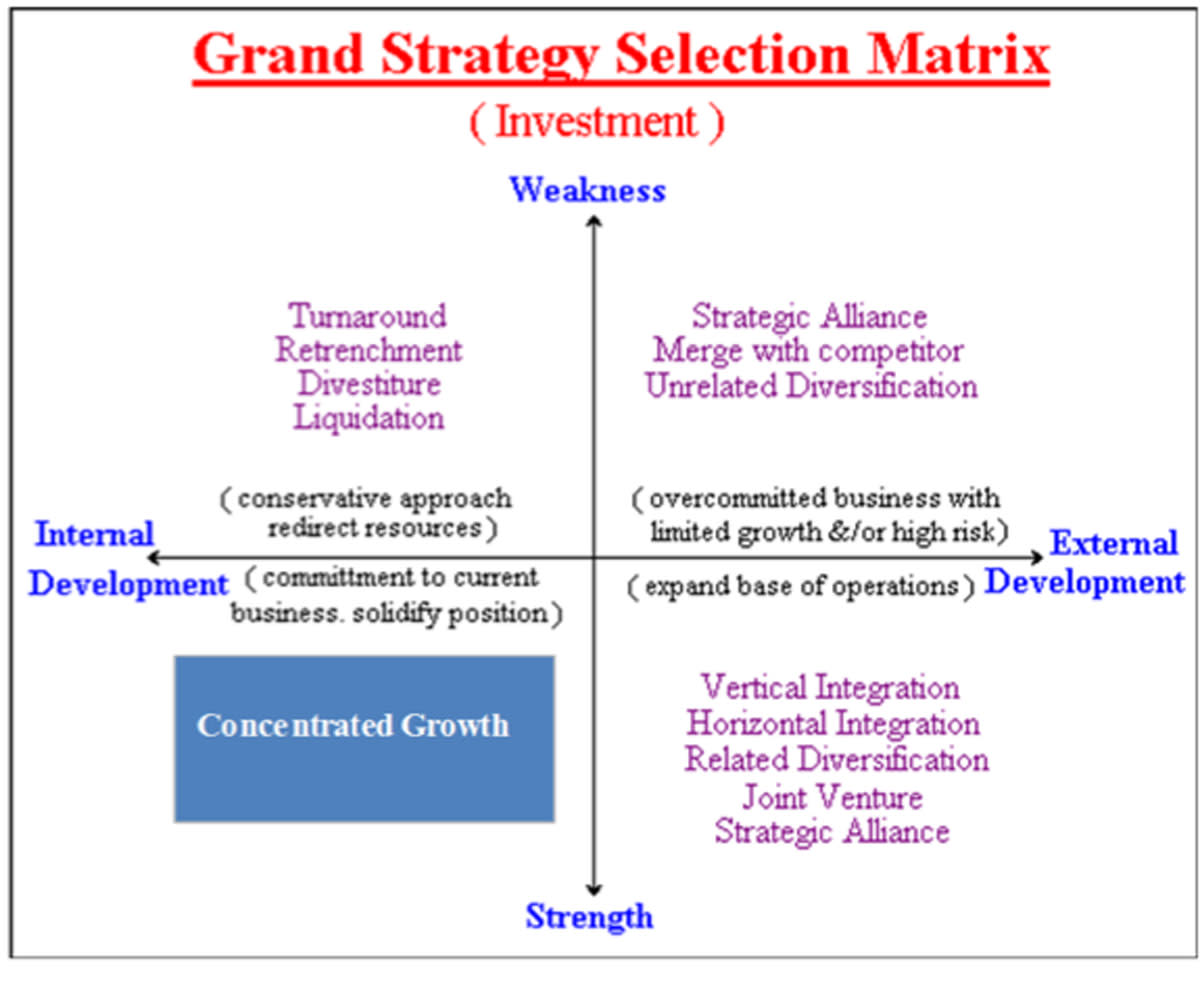
Take-Home Message
By using your analytical skills to determine in which quadrants your practice belongs within these matrices―and which strategic options are shown to be appropriate―you can develop recommendations for action. Use the models to logically see which options emerge. Your recommended actions then flow from good research, solid analysis and integrative thinking.
After consideration of the strategies that emerged from the exercise, ABC Equine’s strategic action plan includes:
1) instituting internal changes of more effective communication and enhanced compassion in order to bring performance to a higher level and capitalize on the competitive advantage of “caring”;
2) launching an innovative Wellness Program to capture value that might otherwise transfer to another practitioner, while continuing a robust price structure for commodity items in order to maintain neighboring small practices’ goodwill, insuring their continued referrals;
3) creating an Emergency Service Division as a related diversification strategy to build loyalty to ABC Equine, as well as creating an additional revenue stream;
4) merging with several small local practices to form a much larger entity, ensuring continued referrals and allowing economies of scale.
After determining these options for action, think about the managerial and competitive implications your actions could spawn, and enjoy the excitement that the creation of an inspiring vision of the future will bring. By investing the time to think strategically, you can move in the direction that makes the most sense for your practice.
(Editor’s note: A template to use for the performing strategic analysis and planning for your practice is available from Dr. Grice. Email her at amygrice@amygrice.com.)








